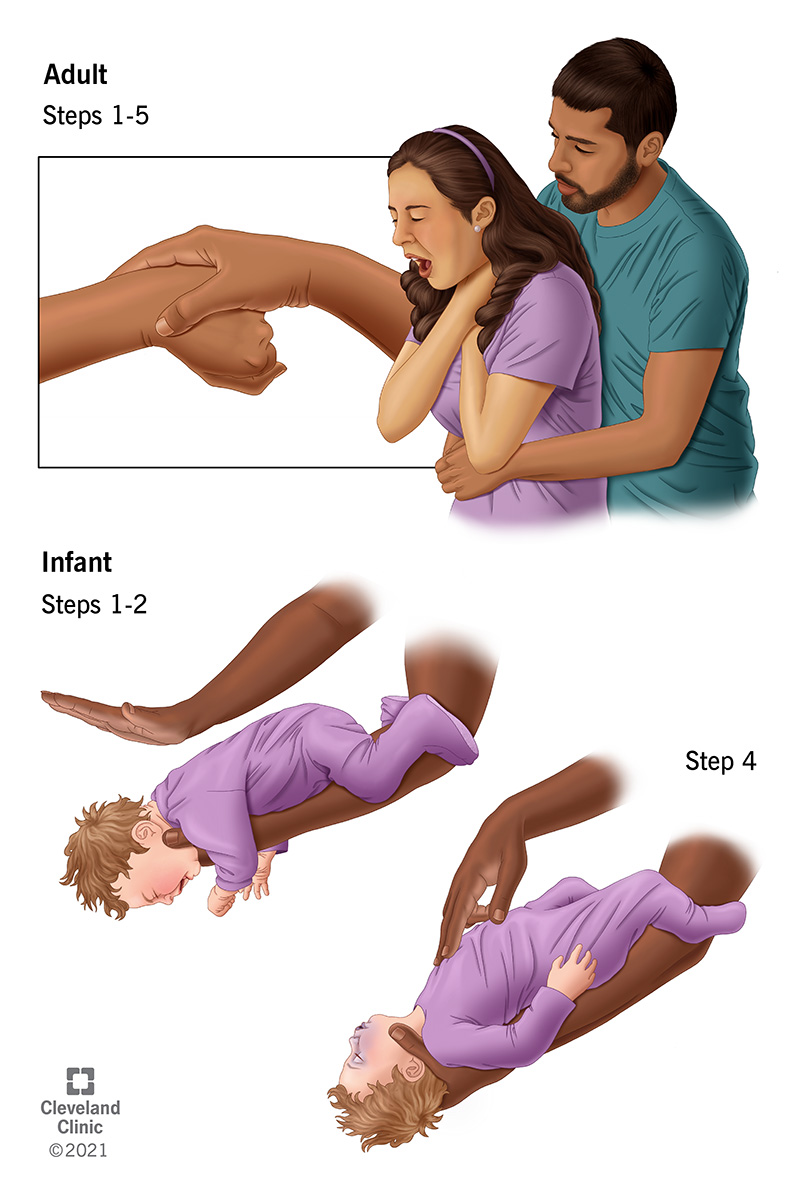The Heimlich maneuver is a first-aid method for choking that you can use on adults and children. Another name for the Heimlich maneuver is abdominal thrusts, because it involves thrusting into the abdominal area. It’s a quick and life-saving method, but you should only use it on conscious people who can’t breathe on their own.
Advertisement
Cleveland Clinic is a non-profit academic medical center. Advertising on our site helps support our mission. We do not endorse non-Cleveland Clinic products or services. Policy
The Heimlich maneuver is a first-aid method for choking. Choking is when a person can’t breathe because food, a toy or another foreign item is blocking their throat or windpipe (trachea). Another name for the Heimlich maneuver is abdominal thrusts. You can use it in different ways on adults and children.
Advertisement
Cleveland Clinic is a non-profit academic medical center. Advertising on our site helps support our mission. We do not endorse non-Cleveland Clinic products or services. Policy
Dr. Henry Heimlich invented the Heimlich maneuver in 1974. Dr. Heimlich discovered that the remaining air in a person’s lungs could be used to free (dislodge) a foreign object from their esophagus using quick, upward thrusts under their ribcage.
At first, the Heimlich maneuver didn’t catch on with the medical community. The backslap method remained the most popular first-aid choking treatment for another 10 years. Eventually, the Heimlich maneuver caught on for use in conscious adults. Healthcare providers still recommend backslaps (back blows) for infants, and they recommend CPR for unconscious adults, children and infants.

You should use the Heimlich maneuver if a person is conscious and choking. You can usually tell a person is choking if they can’t speak, breathe or cough. Ask the person, “Are you choking?” They may be able to cough but can’t speak to ask for help. Sometimes, their breathing and speaking become weaker and weaker until only gasping sounds come out. People often use the universal choking symbol — holding your hands up and clutching your throat.
If a person is able to speak, cough or breathe, don’t attempt the Heimlich maneuver. Encourage the person to keep coughing. Sometimes a strong cough can free the foreign object. Only perform the Heimlich maneuver if a person’s life is in danger.
Advertisement
To perform the Heimlich maneuver, follow these steps:
You can perform the Heimlich maneuver on toddlers and children. If the child is younger than 5 years old or weighs less than 45 pounds (20 kilograms), you should alter the method slightly. First, you should kneel behind the child to get down to their level. Then, you should use less forceful thrusts than the typical Heimlich maneuver requires.
Healthcare providers don’t recommend the Heimlich maneuver for use on infants 12 months or younger. Instead, you should use backslaps (back blows) on babies.
To perform this method, follow these steps:
Women who are pregnant or people who have obesity can receive the Heimlich maneuver in a slightly altered way. Instead of thrusting on their abdomen, you should place the thrusts on their breastbone (sternum).
If you’re alone and choking, you can try to free the item by performing the Heimlich maneuver on yourself.
To perform this method, follow these steps:
You can also try leaning over a railing, chair or table edge. Then, sharply and quickly thrust your upper abdominal area against the edge.
Infants shouldn’t receive the Heimlich maneuver. In addition, if a person is unconscious, they shouldn’t receive the Heimlich maneuver. Instead, you should perform CPR.
Healthcare providers consider the Heimlich maneuver a safe and quick method to save lives. You don’t have to have any medical knowledge or training to perform the Heimlich maneuver. But if you don’t perform the Heimlich maneuver correctly, you can do serious harm.
Advertisement
If you aren’t able to dislodge the foreign object after the first few sets of thrusts, problems can occur. The most common complications of the Heimlich maneuver are broken ribs and holes in the gastrointestinal tract. Other rare abdominal complications can happen, but in a life-or-death situation, providers still recommend performing the Heimlich maneuver.
Young children are at a high risk of choking. To prevent your child from choking:
When someone can’t breathe because of a blockage (obstruction) in their upper airway, seconds count. You could save a life by performing the Heimlich maneuver. You don’t have to have any medical training to perform it, but it’s a good idea to know the steps in case the situation ever arises. You may even need to use it on yourself one day. The Heimlich maneuver can be a life-saving rescue technique, but you should only use it if the person can’t breathe and they’re still conscious.
Advertisement
Whether you need stitches, a broken bone set or think your appendix might be causing your abdominal pain, Cleveland Clinic’s emergency medicine team is here to help.

Last reviewed on 02/13/2024.
Learn more about the Health Library and our editorial process.